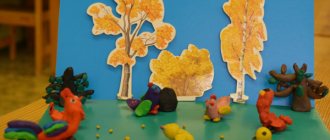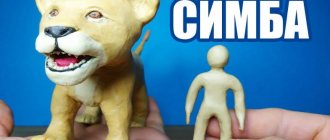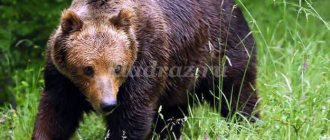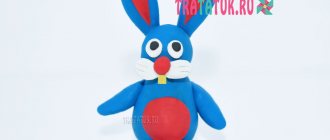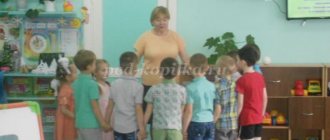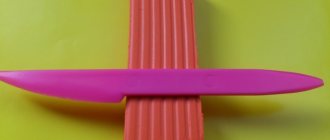Modeling techniques for the composition “Cockerel with his family”
According to the Federal State Educational Standard, the topics of modeling lessons are repeated annually, but differ in the level of complexity of techniques for making crafts. Children 6–7 years old:
- develop the skill of turning “sausages” into flagella, for example, to show the feathers on the tail of a rooster;
Children of the preparatory group learn to convey the plot in the poses and movements of the figures
- improve the skill of forming “peas” from “balls” for the eyes of birds;
- practice the skill of smoothing seams when pinching parts, for example, a neck with a head and torso;
- learn to pull back plasticine to get pointed elements, for example, a rooster's beak;
- reinforce the skill of creating identical parts in shape and size, for example, bird wings;
- choose the colors of plasticine for the figures themselves;
Using certain shades of plasticine, children should rely on a familiar image: fairy-tale or real
- They use stacks to give the elements of the craft a relief.
Kitten with a heart
On Valentine's Day, you can give not only valentines, but also original crafts. We recommend that you make a kitten from plasticine step by step according to the photo instructions provided.
Sculpting technique:
- From a blue base, mold a body in the shape of a heart, a tail, and ears.
- Connect these parts and stick stripes of a lighter shade on top, creating a “cat” color.
- Make the muzzle, eyes and nose as shown in the photo.
- Detail the animal's face using a stack.
- All that remains is to attach the paws, the heart is made from a red base.
- The holiday craft is completely ready.
What types of modeling are suitable for the theme “Cockerel with his family”
To embody the theme, plot modeling is used. However, other types are also involved in the work.
Subject modeling
Combining birds sculpted using object technique into a common mise-en-scène makes it possible to develop entire scenes where the figures are presented not only statically, but also dynamically, that is, with wings spread for flight, with a bowed head, an outstretched neck, etc.
For plots, children sculpt figures with heads turned and wings in different positions.
Object modeling
Children convey the image of a rooster, hen and chicks as accurately as possible, focusing on the picture or their own ideas about the bird. Then the individual figures are combined into an overall composition. In this type of modeling, children actively use stacks and sticks to add texture to the wings, that is, they make the image realistic.
Object modeling involves the creation of individual figures, which are then combined into an overall composition, that is, a plot
Decorative modeling, that is, the creation and decoration of crafts based on folk crafts, is connected to the theme “Cockerel with his family” if the figurine of the “head of the chicken family” is stylized as a Filimonovsky or Dymkovo cockerel.
Decorative modeling in the preparatory group involves painting clay bases, that is, a very labor-intensive process, so this type of modeling is usually practiced in circle classes
Plasticineography
Elements of a plasticine drawing on the theme “Cockerel and his family” are used, as a rule, to decorate the background for the mise-en-scène, which is prepared in advance, for example, during the children’s independent activities on the eve of class. Or they represent a separate type of fine art - plasticineography.
In compositions for modeling, plasticineography is used to design the base.
Modeling techniques
The theme “Cockerel and his family” is realized using five modeling techniques.
Sculptural (plastic)
The figurine is created from one piece of plasticine by stretching, smoothing or pinching elements. Children 6–7 years old practice precision manipulation with plasticine, trying to make the details as naturalistic as possible: a pointed beak, a thin crest, an elongated neck that smoothly turns into a body, claws on the paws, etc.
Sculptural modeling in the preparatory group is complicated by the active use of stacks to add texture to the image
Constructive modeling
This technique consists of combining finished parts into a single composition. So, to create a chicken, children separately form an oval-shaped body, a round head, an elongated ball turning into a cone for the beak, “sausages” of legs, elongated “pancakes” for the wings, and a rounded shape for the tail.
Particular emphasis is placed on the accuracy of smoothing and smearing of elements.
In constructive modeling, all the details are first prepared, and then a solid figure is assembled from them.
Combined technique
The combination of sculptural and constructive modeling is called a combined technique. For example, using a sculptural method, a torso is made from one piece of oval-shaped plasticine and the neck and head are extended from it. And the wings, paws, tail, comb and beard are attached from separately sculpted elements made using constructive techniques.
In a combined technique, children usually sculpt their torso and head.
Modular technology
Modeling is based on combinations of modules - separately sculpted figures, representing 2-3 independent plots, which are complemented by details and combined into a single composition. For example, a cockerel, a hen, a chick in the framework of crafts on the theme “Poultry” are supplemented with grass, a house, and an appropriate description and the craft “Cockerel with his family” is obtained.
In this composition, the modules are cockerels, which were combined into one plot: birds peck grain
Modeling according to shape
Waste material is used in the sculpting of bird figurines, for example, toy cases in Kinder Surprise, which are covered with plasticine and supplemented with separately sculpted wings, tail and beak. This technique produces funny yellow chickens.
The shape of chickens is familiar to children from the middle group; in preparatory crafts they are complicated by the use of additional materials - ready-made eyes, which need to be carefully and symmetrically glued on
How to present
There are many options for how to present a family tree in an original way. The main thing you need to take care of is the design. You can arrange the composition in different ways:
- Modern way. To do this, you need to contact a company that provides printing services. Using a special program, you can create a family tree and print it. The print can be made on canvas and then framed. It is better to save the electronic version, as it can then be supplemented and updated.
- Classic book. This option will be similar to an album, only the photos will be displayed in a certain order. Each photo has a caption with brief information about the person depicted in it.
- Of all the original methods, one can highlight graffiti, which is painted directly on the wall in an apartment or house. The wall will allow you to accommodate a large number of family members, and also, over time, add new family members to the tree.
- A decorative tree made by yourself will give warmth and comfort to your home and will remind you of your ancestors. To make it, available materials are taken - plywood (the tree is flat), branches and decorations for them made of paper and ribbons (the product is three-dimensional), wire and beads. Overall this is a wonderful idea for interior decor.
If you add a verse to a gift, it will complement and add zest. Kind words can be printed separately or directly on part of the gift, for example, on a tree trunk. It is also good to present congratulations orally, as a special sign of attention.
Creating the Foundation
Thin cardboard serves as a backing for the composition “Cockerel with Family”. If it is assumed that not only birds, but also other elements will be placed on the base: a fence, a lawn with grass, a well, etc., then the base must be made in advance. Usually, children are allocated time for independent activity after nap time for this work. Preschool children cover the substrate with plasticine, sculpt details of the surroundings - a fence, a house, etc. - and choose a suitable place for them on the base.
Hedgehog
A small forest animal with thorns will end up right on your table. Even a small child can make a cute rodent. Modeling from plasticine for children is incredibly exciting fun.
How to make:
- Prepare the materials necessary for work. Make a small ball from a brown base.
- Now you need to stretch the resulting workpiece a little; the ball should turn into a drop-shaped figure.
- Next, we sculpt a nose and eyes for the hedgehog from plasticine with the children. Attach everything to the body.
- You will need to place the seeds on the surface of the sculpted figure with the pointed part facing up. Attach the “needles” in the same way as shown in the photo.
- When the empty spaces on the body of the forest animal are filled with seeds, place the plasticine figurine on the cardboard. All is ready!
Materials for modeling
The leading material for creating the “Cockerel with Family” craft is plasticine; clay and salt dough can also be used. In this case, the modeling can be supplemented with origami details. For example, the cockerel and hen are made of plasticine, and the chickens are made of yellow paper. Another option for decorating crafts is adding natural materials. Thus, the tail feathers can be made from natural bird feathers.
Natural feathers for decorating the tail can be pre-painted with paints
Modeling tools
When organizing a workspace for modeling, you need to ensure the availability of:
- frames - sticks of different lengths/thicknesses (or toothpicks) for fastening parts or supporting structures;
- stacks (pointed and rounded);
- special board or mats for work.
Features of modeling in the preparatory group
Types of sculpting:
- subject - a generalized image of the characteristic features of individual objects (duck, owl, crow, etc.);
- plot - a composition of several objects and objects, an artistic embodiment of episodes from fairy tales, literary works (K. Ushinsky “Cockerel with his Family”) or scenes from the surrounding life (“Cockerel with a Hen”, “Hen with Chicks”), practiced only in the older and preparatory groups;
- decorative - a plastic embodiment of the image of a cockerel and a hen in the style of traditional techniques of folk decorative art according to a sketch independently prepared by the child using bright, rich painting (geometric or plant patterns), for example the Filimonovskaya toy, or additional materials (beads, feathers, buttons, shells, seeds ) as an original decoration of the product.
Examples of plot compositions on the theme “Cockerel with his family”
"Cockerel with his family on a walk"
“The Cockerel and the Hen” modeling in the tradition of the Filimonovsky toy “The Filimonov Family”
"Chicken in a cozy nest"
“Easter chicken” made from salt dough
"Naughty cockerels"
Much attention is paid to collective modeling, thanks to which children develop the skills of coordination of actions, teamwork, improve the psycho-emotional qualities of solidarity, and demonstrate feelings of camaraderie and responsibility. When performing a collective composition, the teacher divides the children into subgroups of four to five people and gives them different tasks, for example, one group sculpts cockerels, another - hens, a third - chickens, a fourth - invents and makes decorations.
Examples of collective work
Examples of various tasks on the topic “Cockerel with his family”
"The chicken went out for a walk"
"Filimonovskie cockerels"
"The Cockerel Family"
Technical types of modeling:
- Constructive - with this method, an image is created by combining and connecting different parts or parts as elements of a constructor. A child masters this technique at the age of two or three, inventing a model and its components.
- Sculptural - modeling from a single piece of material, the child kneads and gives the necessary shape, fashioning an image from a shapeless piece, using a whole arsenal of auxiliary small finger movements: stretches the shape of a beak or tail, crushes it to form wings, twists, pinches, conveying the texture of the surface, presses and etc.
- Combined - a large form is sculpted in a sculptural way, for example, the body, and parts and details (wings, tail, beak, eyes) are attached separately using the molding method. In older preschool age, children prefer this particular option for creating products.
- Modeling using a ready-made form - a thin cake of rolled material is wrapped around a durable form (jar, bottle), the excess is removed, and the seams are smoothed. If necessary, carefully remove the frame form. In this topic, this method is most often used to form the body of a cockerel or chickens.
- Modular modeling - a product is created by constructing from ready-made identical elements (modules), for example, balls, flagella, plates, according to the principle of a volumetric mosaic.
Equipment and tools:
- frames (sticks of different lengths and thicknesses), which are used as load-bearing rods or fasteners for parts or parts of a figure;
- stacks - pointed, rounded, as well as in the form of a spatula and a loop of sticks, used to remove excess clay, make cuts for paws or wings and work out details and texture (feathers, eyes, beak) using drawing and strokes;
- special boards, the size of which depends on the size of the figure (for a figure of 15x20 cm, a board of 22x35 cm is suitable) or rotary machines.
Special boards are usually used for modeling
Characteristic features of modeling work for older preschoolers:
- The desire to more accurately convey the shape of an object, to complement it with secondary details (decorative decorations, external interior or scenery for a plot composition), to depict it in motion.
- Independent selection of an episode, implementation of work planning.
- A wide range of techniques and materials used (clay, plasticine, dough).
- The works of children of senior preschool age embody a generalized image that conveys the vivid characteristics of an object without deep specification and elaboration of details.
Basic skills and knowledge acquired by six-year-old children at previous stages and options for their further development:
- Ability to distinguish and sculpt the shapes of a ball, cylinder, cone and disk.
- In the preparatory group, children are taught to convey the ratio of quantities (more or less), compare similar objects, create compositions (“Mischievous cockerels”, “Chicken in a cozy nest”, “Chickens for a walk”) from painted clay or colored plasticine and place them on stand.
- Use of the tape method of attaching a tape-shaped base to a base, techniques of pressing and pulling, pinching, mastered in the senior group, studying the method of circular molding. These fine hand techniques are especially in demand in the decorative sculpting process.
- Modeling of birds, animals, toys in the style of folk crafts, for example, a Dymkovo toy, from a single piece by drawing out individual parts or parts; later, children are shown options for sculpting individual parts of a bird figure (head and body from a cone or cylinder, flat modeling of wings) and their connections.
Children with interest not only sculpt a folk toy, but also decorate it with original ornaments.
Options for implementing the topic in the educational process
According to the calendar and thematic plan of the educational direction “Artistic and Aesthetic Development”, modeling classes are supposed to be once every two weeks. The theme “Cockerel with his family” is usually implemented as part of a modeling lesson in the fall or spring, based on personal impressions from a holiday in the village or the story of the same name by K. Ushinsky studied in younger groups.
At the same time, the creation of crafts can be correlated with the topics of other educational courses. For example, acquaintance with folk crafts in classes on familiarization with the environment is realized in January by sculpting a Filimonovsky cockerel, and in the spring, using the same technology, children can sculpt a cockerel with its family as part of a craft project.
Modeling can be a reinforcement of topics for various educational courses
Forms of organization and individual approach
As for the form of organization of work, the theme “Cockerel with his family” can be implemented as an individual or collective craft. In the first case, children prepare the substrate in advance and sculpt birds during the lesson. In the second case, the teacher divides the children into subgroups of 4-5 people and, depending on their proficiency in modeling skills, and also taking into account the wishes of the children, distributes the “front of work”: one subgroup is engaged in sculpting roosters, the second - chickens, the third sculpts chickens, and the fourth is in the process of coming up with designs for the backing. At the same time, children try to make birds in different poses.
Usually in the first and fourth subgroups there are guys who show a special interest in modeling. They can also be given the task of choosing additional material to decorate the craft or compose a story based on the composition.
Collective modeling implies the distribution of responsibilities in the preparation of the substrate: drawings, modeling from natural materials, etc.
One of the forms of implementing an individual approach is to practice modeling techniques. For example, rolling a pencil between the palms to practice the speed of movements of the palms and fingers when forming plasticine parts. And also a good training would be the creation of “flagella,” “pancakes,” and other elements that would correspond to the samples made by the teacher.
Modeling can be an option for organizing independent activities for children who show interest in this type of visual activity.
How to motivate children
The productivity of preschoolers depends on the quality of motivation, which is implemented by a number of techniques at the introductory stage of the lesson.
Table: motivational techniques for modeling classes on the theme “Cockerel with his family” in the preparatory group
| Reception and features of its use | Example |
| Pictures and posters that allow you to most accurately and proportionally convey the shapes of bird body parts. | |
| Conversation | The teacher invites the children to remember what kind of poultry they saw in the village or zoo, what their habits were observed, how the hen takes care of the chickens, what she teaches them, etc. |
| Poems, riddles that allow children to remember the main features of domestic birds (external, lifestyle). |
|
| Cartoon based on the story by K. Ushinsky “Cockerel with his family” for inventing the plot of the composition | Since Ushinsky’s story is studied in the second junior group, in the preparatory group the children repeat the plot and come up with situations where Cockerel could still reconcile all members of his family. For example, when all the chickens began to offend one, the smallest one. |
| Surprise moments for uniting guys in a common cause | Cockerel comes to visit the children and tells how he went for a walk with his family to the pond, but was so enchanted by his reflection in the water that he fell behind the hen and her chicks. And now he asks the children to help him return home by sculpting the composition “Cockerel with his family.” |
| Games |
|
To find differences you need to select bright and memorable images
Video: cartoon based on the story by K. Ushinsky “Cockerel with his family”
Planning a theme week
A thematic week may include events of various types: sporting events (“Mom, Dad, I am a sports family”, physical education sessions with family songs, family matches, etc.), exhibitions and competitions of drawings and crafts, conducting research, defending projects, holding conversations, watching films and cartoons on a certain topic.
Family weeks in kindergarten are a good way to unite the team
Target
The purpose of the thematic week is to develop in children an idea of family life and relationships in it (mutual help, support, distribution of household chores, spending time together), as well as the value for each person.
Lexical topic
The lexical topic is also intended to tell children about the family, its importance, composition and relationships between members. But the main goal of this topic is to expand and update vocabulary and speech development
For your information! A lesson on this topic can be conducted both in a general education preschool educational institution and in groups for children with delayed speech development.
A good exercise can be to select adjectives that characterize each family member. For example, dad (smart, strong, caring, resourceful, loving us and mom), grandmother (sweet, kind, forgetful, loves to cook).
It is also useful to compare the ages of family members (who is older and who is younger).
Based on the results of a family portrait or craft, compose a short story about your loved ones, talking about the composition, joint activities, and household chores.
It is useful to carry out physical education while listening to a family song.
Final event
Note! For the final event, in order to spend time together and strengthen family relationships, it is necessary to hold the event together with children and their family members. A sports holiday “Mom, Dad, I - a sports family” is suitable
The event is held in the kindergarten gym or on the playground, weather conditions permitting. Each family forms a team with its own visual identity, name and motto, which will also be evaluated
A sports holiday “Mom, Dad, I – a sports family” is suitable. The event is held in the kindergarten gym or on the playground, weather conditions permitting. Each family forms a team with its own visual identity, name and motto, which will also be judged.
Tasks for the sports festival:
- "Bowling". Who will knock down more pins with the ball?
- "Get in the basket." Who will throw more balls into the basket with the same number of attempts?
- “Rip it off!” It is necessary to jump a distance while sitting on a fitball and, returning to the team, pass the ball to the next participant.
- "Darts". Calculation of the greatest number of points.
- "Captains Competition" The task is to carry a ping pong ball in a spoon, which must be held in the mouth.
- "Running in sacks." A relay race in which the entire team takes turns jumping a distance in bags.
Running in felt boots not only entertains, but also develops
- "Obstacle course." The task is in the form of a relay race to go through an impromptu obstacle course (jump over a bench, run along a bench, run around a cone, etc.).
- “Resolve!” Team solving puzzles on a family theme.
- “Pull!” Tug of war.
- "Fun Basketball" Who will score more balls into the net with an equal number of attempts.
- "Felt boots". Running in felt boots.
At the end of the event, points are counted, winners are determined, diplomas are awarded to winners and participants, as well as symbolic prizes. The sports festival ends with tea. It is also allowed to integrate creative events into the sports festival.
Mini project
Mini-project: “My family tree.”
Goal: to see and strengthen family ties, to realize oneself as part of a large and friendly family.
Each child is given the task of drawing up a family tree on whatman paper at home together with their parents. You need to do the following:
- depict a tree;
- paste photographs of family members;
- sign their surnames, first names and patronymics, years of birth and death (if no longer alive) and occupation.
Making a family tree will be beneficial
The result of this task will be the defense of your mini-project together with one of the family members (or an open lesson).
For your information! It is important for a parent to help their child prepare a project
Drawing up notes for a sculpting lesson “Cockerel with his family”
The modeling lesson includes three stages of working on the topic:
- introductory, motivating children to work - up to 5 minutes;
- the main one, which includes determining the scheme for completing the craft, the modeling itself, physical education and/or finger gymnastics - up to 20 minutes;
- final, that is, the assessment of the children’s activities by the teacher and reflection - up to 5 minutes.
The purpose of the lesson is specified by the type and technique of creating the craft, for example, creating a plot composition using a constructive technique based on the content of the story by K. Ushinsky “Cockerel with his family.”
The formulation of the tasks implies techniques that will be practiced in the lesson:
- teach children to create, through collective efforts, a simple scene from sculpted figures;
- achieve greater accuracy in conveying the basic shape and characteristic details;
- develop the ability to collectively think about the placement of birds on a stand.
Table: Churakova O.A. Summary of the lesson on collective modeling “Cockerel with his family” based on the story by K. D. Ushinsky in the preparatory group
| Stage | Content |
| Introductory | Educator: - Guys, look at the pictures. Who is depicted there? Children: - Hen, chickens, rooster Educator: - Yes, let's remember what story we recently read, where these heroes are present? Children: - Cockerel with his family Educator: - Well done. Let's remember in more detail what happened in this story by watching the cartoon. (watching a cartoon, talking) Educator: - The chickens ran away, and the rooster and hen went to look for them. Come on, we, too, will go with the cockerel. |
| Basic | Physical education (In accordance with the text, children take steps in place, holding their hands behind their backs. Then they make circular movements with their hands, squat, shake their fingers, bend forward). |
| Children sit down. Teacher: - Guys, we have already been divided into groups, let’s remember who will sculpt what and start sculpting. Children with a teacher look at a model sculpted by the teacher. The teacher pays attention to the color and shape: the body is a big ball, the head is a small ball, the beak (small, sharp). | |
| Educator: - I take a small piece of plasticine and what do I do? I roll out the ball. This will be the chicken's head. Then I take a large piece of plasticine and also roll out the ball. This will be the body of the bird. Now we fasten the two balls by pressing them against each other. And now we make a beak, pinch it with two fingers. | |
| Finger gymnastics: Our cockerel suddenly woke up and turned straight to the sun. Crowed once, twice, three times! Don't oversleep today. | |
| Doing work by children. Individual assistance for children. | |
| Final | Placing finished works on a stand, examining and evaluating children's works. |
| Quote from: https://www.maam.ru/detskijsad/konspekt-nod-lepka-petushok-s-semei-po-raskazu-kd-ushinskogo-kolektivnaja-kompozicija.html | |
